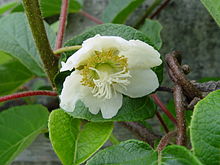Actinidiaceae
| Actinidiaceae | |
|---|---|

| |
| Actinidia deliciosa | |
| Scientific classification | |
| Kingdom: | Plantae |
| Clade: | Tracheophytes |
| Clade: | Angiosperms |
| Clade: | Eudicots |
| Clade: | Asterids |
| Order: | Ericales |
| Family: | Actinidiaceae Gilg & Werderm.[1] |
| Type genus | |
| Actinidia | |
| Genera | |
The Actinidiaceae are a small family of flowering plants. The family has three genera and about 360 species and is a member of the order Ericales.[2]
Distribution
They are temperate and subtropical woody vines, shrubs, and trees, native to Asia (Actinidia or kiwifruit, Clematoclethra, and Saurauia) and Central America and South America (Saurauia only). Saurauia, with its 300 species, is the largest genus in this family. Although now confined to Asia and tropical Central and South America, evidence indicates in the past the family had a wider distribution. The now extinct genus Parasaurauia is thought to have belonged to the Actinidiaceae and lived in North America during the early Campanian.[3]
Characteristics
The plants are usually small trees or shrubs, or sometimes vines (Actinidia). The alternate, simple, spiral leaves have serrated or entire margins. They lack stipules or are minutely stipulated. They are often beset with rather flattened bristles.
The
The plants may be
Evidence supporting placement within the Ericales
Before genetic evidence appeared in the last 10 years, the placement of the Actinidiaceae within the Ericales was highly controversial. The
Evidence supporting monophyly of the Actinidiaceae
What genera were to be placed in the Actinidiaceae before recent genetic and micromorphological studies emerged was highly controversial. Before recent evidence, the genus
References
- hdl:10654/18083. Retrieved 2013-07-06.
- PMID 21665668.
- ^ .
- JSTOR 2992015.
- S2CID 35461118.
- JSTOR 3093880.)
{{cite journal}}: CS1 maint: DOI inactive as of January 2024 (link - .
